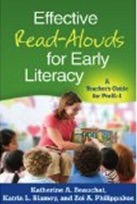by Megan McCaffrey & Katy Hisrich
 Good Read Alouds do not just happen by chance, they are created through conscientious planning. Research shows there are specific qualities of a read aloud necessary in order to optimize the effectiveness of the activity. According to Shedd and Duke (2008) an effective read aloud needs high quality literature, and open-ended questioning which takes time to plan.
Good Read Alouds do not just happen by chance, they are created through conscientious planning. Research shows there are specific qualities of a read aloud necessary in order to optimize the effectiveness of the activity. According to Shedd and Duke (2008) an effective read aloud needs high quality literature, and open-ended questioning which takes time to plan.

Unwrapping the Read Aloud: Making Every Read Aloud Intentional and Instructional
by Lester Laminack
Book selection is an essential part of planning for a read aloud. A book must first and foremost be engaging. Getting to know books takes time and a commitment to investigate and read many children’s books. While getting to know books other considerations for evaluating their use include: bold illustrations that help move the storyline forward, reflect the demographics of the class, exposure to a variety of genres, are conducive to use for literacy instruction and that evoke discussion for oral language and vocabulary growth.

Effective Read-Alouds for Early Literacy: A Teacher’s Guide for PreK-1
by Katherine A. Beauchat EdD and Katrin L. Blamey PhD
Asking questions before, during, and after a read aloud makes a story much more interactive which in turn helps develop critical literacy skills, and as previously stated – discussions helps promote oral language. Use of a variety of both recall and extended questioning is best though open-ended questions invite children to give answers with more depth than simpler one or two word answers. Planning for questions occurs so that the teacher knows where the most advantageous places to ask questions in the story exist. When reading a story aloud for the first time, the use of sticky notes can help cue a teacher for better questioning.
Purposeful planning for a read aloud increase the likelihood of a successful reading activity that in turn is more likely to deepen literacy skills. Especially in the early childhood and elementary grades when read alouds are more common practices planning can increase the literacy gains amongst students.
Journey through Worlds of Words during our open reading hours: Monday-Friday, 9 a.m. to 5 p.m. and Saturday, 9 a.m. to 1 p.m. To view our complete offerings of WOW Currents, please visit archival stream.
array(15) {
["_edit_lock"]=>
array(1) {
[0]=>
string(14) "1571250350:279"
}
["_edit_last"]=>
array(1) {
[0]=>
string(3) "279"
}
["_oembed_177edf64a942e1770339343c0981450f"]=>
array(1) {
[0]=>
string(11) "{{unknown}}"
}
["_social_aggregated_ids"]=>
array(1) {
[0]=>
string(47) "a:2:{s:7:"twitter";a:0:{}s:8:"facebook";a:0:{}}"
}
["_social_aggregation_log"]=>
array(1) {
[0]=>
string(1347) "a:20:{i:1448303273;O:8:"stdClass":2:{s:6:"manual";b:0;s:5:"items";a:0:{}}i:1448305088;O:8:"stdClass":2:{s:6:"manual";b:0;s:5:"items";a:0:{}}i:1448308674;O:8:"stdClass":2:{s:6:"manual";b:0;s:5:"items";a:0:{}}i:1448312302;O:8:"stdClass":2:{s:6:"manual";b:0;s:5:"items";a:0:{}}i:1448320399;O:8:"stdClass":2:{s:6:"manual";b:0;s:5:"items";a:0:{}}i:1448335686;O:8:"stdClass":2:{s:6:"manual";b:0;s:5:"items";a:0:{}}i:1448364516;O:8:"stdClass":2:{s:6:"manual";b:0;s:5:"items";a:0:{}}i:1448408609;O:8:"stdClass":2:{s:6:"manual";b:0;s:5:"items";a:0:{}}i:1448495014;O:8:"stdClass":2:{s:6:"manual";b:0;s:5:"items";a:0:{}}i:1448668701;O:8:"stdClass":2:{s:6:"manual";b:0;s:5:"items";a:0:{}}i:1448908074;O:8:"stdClass":2:{s:6:"manual";b:0;s:5:"items";a:0:{}}i:1448909918;O:8:"stdClass":2:{s:6:"manual";b:0;s:5:"items";a:0:{}}i:1448913475;O:8:"stdClass":2:{s:6:"manual";b:0;s:5:"items";a:0:{}}i:1448917144;O:8:"stdClass":2:{s:6:"manual";b:0;s:5:"items";a:0:{}}i:1448925182;O:8:"stdClass":2:{s:6:"manual";b:0;s:5:"items";a:0:{}}i:1448939621;O:8:"stdClass":2:{s:6:"manual";b:0;s:5:"items";a:0:{}}i:1448969272;O:8:"stdClass":2:{s:6:"manual";b:0;s:5:"items";a:0:{}}i:1449012476;O:8:"stdClass":2:{s:6:"manual";b:0;s:5:"items";a:0:{}}i:1449098889;O:8:"stdClass":2:{s:6:"manual";b:0;s:5:"items";a:0:{}}i:1449272573;O:8:"stdClass":2:{s:6:"manual";b:0;s:5:"items";a:0:{}}}"
}
["_social_notify"]=>
array(1) {
[0]=>
string(1) "1"
}
["_yoast_wpseo_focuskw_text_input"]=>
array(1) {
[0]=>
string(30) "Planning Effective Read Alouds"
}
["_yoast_wpseo_focuskw"]=>
array(1) {
[0]=>
string(25) "planning for a read aloud"
}
["_yoast_wpseo_metadesc"]=>
array(1) {
[0]=>
string(142) "According to Shedd and Duke (2008) an effective read aloud needs high quality literature, and open-ended questioning which takes time to plan."
}
["_yoast_wpseo_linkdex"]=>
array(1) {
[0]=>
string(2) "80"
}
["_yoast_wpseo_content_score"]=>
array(1) {
[0]=>
string(2) "30"
}
["_yoast_wpseo_primary_category"]=>
array(1) {
[0]=>
string(0) ""
}
["_thumbnail_id"]=>
array(1) {
[0]=>
string(5) "37464"
}
["_yoast_wpseo_opengraph-image"]=>
array(1) {
[0]=>
string(45) "https://wowlit.org/wp-content/media/16097.jpg"
}
["_yoast_wpseo_opengraph-image-id"]=>
array(1) {
[0]=>
string(5) "26098"
}
}
 Good Read Alouds do not just happen by chance, they are created through conscientious planning. Research shows there are specific qualities of a read aloud necessary in order to optimize the effectiveness of the activity. According to Shedd and Duke (2008) an effective read aloud needs high quality literature, and open-ended questioning which takes time to plan.
Good Read Alouds do not just happen by chance, they are created through conscientious planning. Research shows there are specific qualities of a read aloud necessary in order to optimize the effectiveness of the activity. According to Shedd and Duke (2008) an effective read aloud needs high quality literature, and open-ended questioning which takes time to plan.


Books, especially read alouds, are a great resource for getting students to make connections to personal experiences and get them talking more. It has happened before that when I read out loud to students I become nervous and forget to ask prediction questions before beginning to read and I felt that the children did not get as much out of the text. There is so much that can be done and learned through books and I agree with the blog that students can learn critical literacy skills and work on their oral language. Sticky notes are great for writing down questions and they also help for knowing when to stop and get the children involved. I also like to leave them in the book for whenever I want to reuse that book I can see what questions I have asked before and either use or change them.